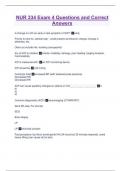NUR 334 Exam 4 Questions and Correct
Answers
Is change in LOC an early or late symptom of IICP? ✅early
Priority to look for, earliest sign - could present as behavior change, change in
alertness, etc.
Other s/s include HA, vomiting (nonspecific)
S/s of IICP in children ✅infants: irritability, lethargy, poor feeding, bulging fontanel,
macrocephaly
ICP is measured with: ✅an ICP monitoring device
ICP should be ✅<20 mmhg
Cushing's triad ✅increased BP (with widened pulse pressure)
Decreased HR
Decreased RR
IICP can cause pupillary changes w/ edema on CN ____, ____, ____, ____ ✅II
III
IV
VI
Common diagnostics (IICP) ✅neuroimaging (CT/MRI/PET)
Skull XR (esp. For shunts)
EEG
Brain biopsy
LP
LP ✅informed consent
Post procedure: lay flat to avoid spinal HA (24 hours but 30 minutes required), avoid
heavy lifting (can cause clot at site)
,Note: lps done for any newborn less than 6 weeks that has a fever (in addition to
blood/urine culture, abx)
Clinical management (IICP) ✅multiple treatment strategies, depends on underlying
condition
Goal: prevent secondary injury to brain by improving and maintaining cerebral perfusion
by *reducing cerebral edema* & *reducing intracranial pressure*
Surgical interventions (IICP) ✅craniotomy may be performed to remove a tumor,
lesion, repair damaged area, relieve pressure, drain hematoma
Decompressive craniectomy: removes rigid confines of skull, allows for expansion of
cranial contents and lowers ICP
Sterotactic procedures: to make sure you're accessing the right part of the brain, halo
holds head still in machine to map out where they want to go in the brain
Hydrocephalus s/s ✅bulging anterior fontanel, eyes deviated downwards ("setting sun
eyes")
Shunt procedures for hydrocephalus ✅provides pathway for CSF to drain
Surgical procedure
Can sometimes see shunt under skin in head
"VP" shunt - drains into peritoneum
Interventions to lower ICP ✅position HOB 30 degrees
Head/neck midline to facilitate venous return in jugulars
Activity mgmt: focus on not increasing O2 demand when performing nursing tasks
Distribute cares (vs clustering of tasks)
Hyperventilation: only temporary, used to reduce ICP in TBI pts (but decreases
perfusion, negatively impacting O2 delivery)
Bowel mgmt to reduce straining
________ can exacerbate or cause IICP so pts are sometimes placed on prophylactic
_________ ✅seizures
Anti-seizure medications
, CVA non-modifiable risk factors ✅age (risk doubles each decade after 55)
Gender (more common in men, more women die)
Race (more common in African Americans often d/t HTN, also Native Americans)
Heredity/fhx
CVA modifiable risk factors ✅HTN, CAD, DM, increased cholesterol, smoking,
alcohol/drug use, waist circumference/obesity, nutrition, OCP
TIA ✅transient ischemic attack
Risk factor associated with stroke
Transient episode of dysfunction w/o infarction in the brain
Clinical s/s last <1 hour
May be d/t micro emboli that temporarily block the blood flow
Ischemic stroke ✅inadequate blood flow from partial or complete occlusion of an artery
80% of all strokes
Thrombotic: injury to blood vessel and clot formation, most common type,
atherosclerosis common
Embolic: embolus like plaque/clot/other debris breaks off and enters circulation, 2nd
most common type, a/w heart conditions like afib and valve issues
Hemorrhagic stroke ✅bleeding into brain tissue or subarachnoid space or ventricles
Intracerebral hemorrhage: caused by rupture of vessel within brain, HTN most common
cause, poor prognosis
Subarachnoid hemorrhage (SAH): IC bleeding into the CSF filled space between
membranes on top of brain, usually d/t ruptured aneurysm ("silent killer")
Clinical manifestations of stroke ✅akinesia, spasticity, flaccidity, aphasia, dysphasia,
uncontrollable emotions, impaired memory/judgement, perception/distance judging
problems, elimination/bowel/bladder incontinence, sudden severe HA w/o known cause,
dizziness, unsteadiness, sudden falls, dimness or loss of vision (partic. In one eye),
sudden weakness/numbness of face/arm/leg (unilateral)




